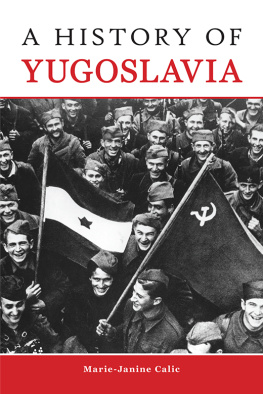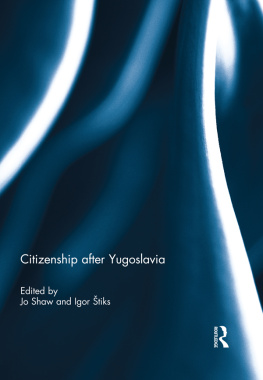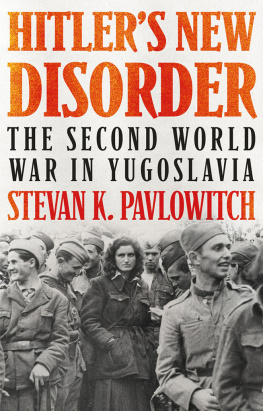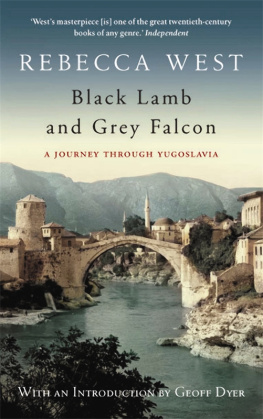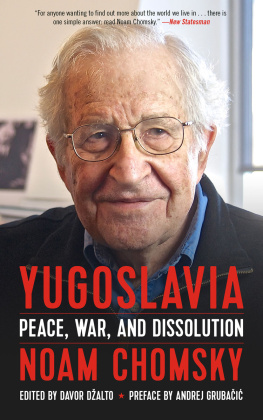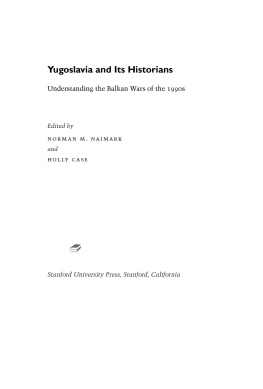Contents

A History of Yugoslavia
Central European Studies
Paul Hanebrink, editor
Maureen Healy, editor
Howard Louthan, editor
Dominique Reill, editor
Daniel L. Unowsky, editor
A History of Yugoslavia
Marie-Janine Calic
Translated by Dona Geyer
Purdue University Press West Lafayette, Indiana
Copyright 2019 by Purdue University. All rights reserved.
Printed in the United States of America.
Cataloging-in-Publication data is on file at the Library of Congress.
Paperback ISBN: 978-1-55753-838-3
ePDF ISBN: 978-1-61249-563-7
ePUB ISBN: 978-1-61249-564-4
Knowledge Unlatched ISBN: 978-1-55753-849-9
Originally published in German as Geschichte Jugoslawiens im 20. Jahrhundert by Marie-Janine Calic. Verlag C.H.Beck oHG, Mnchen 2014.
Cover image: picture-alliance//HIP Media number: 14502633
Contents
PART I
THE SOUTH SLAVIC MOVEMENT AND THE FOUNDING
OF THE YUGOSLAV STATE (1878 TO 1918)
PART II
THE FIRST YUGOSLAVIA (1918 TO 1941)
PART III
THE SECOND WORLD WAR (1941 TO 1945)
PART IV
SOCIALIST YUGOSLAVIA (1945 TO 1980)
PART V
AFTER TITO (1980 TO 1991)
PART VI
THE DEMISE OF YUGOSLAVIA (1991 TO THE PRESENT)
Why did Yugoslavia fall apart? Was its violent demise inevitable? Did its population simply fall victim to the lure of nationalism? How did this multinational state manage to survive for so long? And where do we situate the short life of Yugoslavia in the long history of the twentieth century? This book tells the story of why and under which conditions Yugoslavia was created, what held the multinational state together for more than seventy years, and why it finally broke apart in violence. It is a tale of confidence and doubt, of progress and decline, of extremes and excesses, of utopia and demise.
No other European country was as colorful, multifaceted, or complex as Yugoslavia. Its turbulent history made it a byword for Balkan confusion and animosity; it stood for the backward, barbaric, and abhorrent contrast to the supposedly so civilized European continent. At the end of the nineteenth century, to cross the Danube by steamboat from the Austrian city of Semlin (Zemun) to Belgrade or travel by the Hungarian state railway over the great iron Sava Bridge to reach the train station of Bosanski Brod was to enter an exotic world that appeared both mysterious and fabulous but also at times appalling and threatening.
In contrast, this book addresses Yugoslav history from the perspective of the major social, economic, and intellectual changes that affected all of Europe at the turn of the twentieth century and marked its transition to modern industrialized mass society. The great acceleration first reached Western societies but soon expanded out toward the European periphery.
In Southeast Europe, the economy, social relations, cultural expression, mentalities, and daily life were undergoing fundamental transformation in the decades around 1900. The region also faced unanticipated challenges from the scientific-technological and economic progress of the West. Growing international competition and aggressive imperialism made it imperative to overcome backwardness as a matter of survival, in a very literal sense. It was against this background that the South Slavic idea took shape: the project of a common political future for culturally related peoples unified in a single state. After all, the liberation from foreign rule and the founding of an independent and sovereign Yugoslavia appeared to be the premise for securing a self-determined future in Europe.
Twice, in 1918 and 1945, Yugoslavia became a reality, each time with a thoroughly different political system: first as a centralized, constitutional, and parliamentary monarchy, then as a one-party socialist federation. Both models faced four fundamental long-term problems: the unresolved national question that challenged the identity and cohesion of the state; the underdevelopment and poverty in a predominantly peasant society; and the dependence on foreign political and economic powers. These three problems exacerbated the fourth, namely the enormous historical, cultural, and socioeconomic disparities between the various components of multiethnic Yugoslavia, which repeatedly raised anew issues concerning political legitimacy and a suitable constitutional order.
One of the main questions addressed here is how, under these circumstances, development and progress were conceived at various times and what means were employed to pursue them. An increasing number of the elite believed that they were living in an age in which tradition, customs, patriarchy, and long-existing community relations were vanishingand should vanishto make way for the advantages and merits of modernity, specifically of a world of expanding technology. However, competing political forces and intellectuals embraced very different answers to the coercions, aspirations, and challenges of a dramatically changing world. Who were the agents driving social change, and how did they envision the future? What alternatives to Western modernity were discussed?
The approach adopted in this book distances itself from popular explanations of the Yugoslav problem that emphasize ethnic, religious, and cultural divisions, or incompatible and even clashing civilizations. Instead of notorious Balkan intractability and ancient hatreds, the argument presented here stresses the politicization of differences in twentieth-century modern mass society. Peoples, nations, and cultures are not transhistorical entities; they are subject to historical realities and change, and so are conflicts. A central question thus focuses on why, how, and under what conditions ethnic identity and diversity were turned into a matter of contention and by whom. Important are the interests, views, and motives of the major actors, the socioeconomic developments, and, last but not least, the cultural-historical dimensions of collective experiences, memories, and interpretations of history.
Very few scholars have yet attempted to provide a comprehensive history of Yugoslavia covering the entire twentieth century.
In stark contrast to the scarcity of general comprehensive works is the overabundance of books and articles dealing with the Yugoslav wars of the 1990s. For the most part, they interpret Yugoslavias history from the perspective of its bloody demise, analyze its congenital defects, and characterize the creation of the South Slavic state as artificial in order to underscore the inevitability of its failure. Yet Yugoslavia cannot be explained only by the way it began or the way it ended. The state existed for a good seventy years, which raises the question about what held its peoples together for so long and what eventually divided them, a question that has not become obsolete since Yugoslavia fell apart. This book attempts to avoid deterministic explanations and to grasp the history of Yugoslavia as an essentially open-ended process from different thematic approaches.
Many recent studies no longer deal with Yugoslavia but concentrate entirely on its successor states. The existence of Slovenia, Croatia, or Kosovo today is interpreted retrospectively and the past is read teleologically, as if distant history was a harbinger of modern statehood. Interactions with neighbors are often presented only in the form of conflicts and wars. In the process, the Yugoslav period is reduced to a very shortalbeit not completely insignificantepisode in a centuries-long national history. By contrast, the objective of this book is to encapsulate various local and national historical perspectives and place them in relation to one another, which then relativizes many an alleged regional particularity. However, in order to maintain a balance between diversity and unity, the various republics and peoples can only be treated in an illustrative manner. In many instances, Eastern Bosnia serves as the microhistorical example, for it is the proverbial heart of Yugoslavia over which many sides have fought in the course of the twentieth century.

